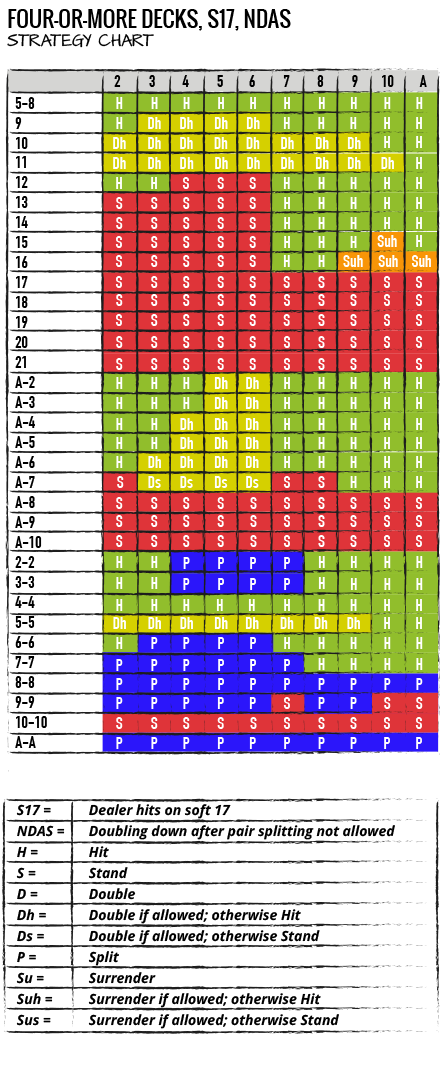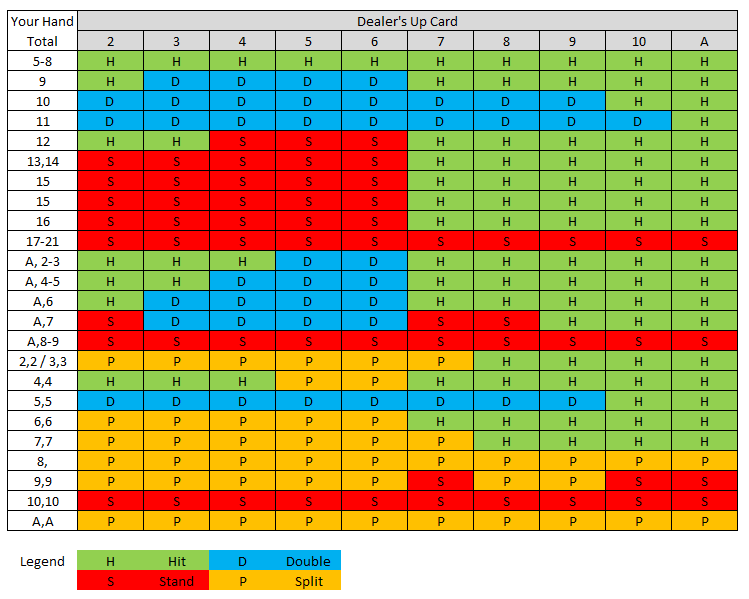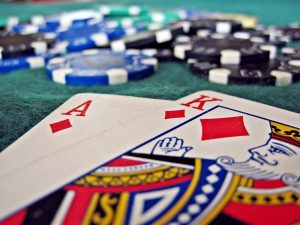Blackjack Casino Strategy Chart
- Blackjack Casino Strategy Chart Blackjack
- Blackjack Casino Strategy Chart Example
- Blackjack Casino Strategy Chart Free
Blackjack offers one of the lowest house edges you can find on the casino floor but if you insist on winning at this game, you will need to master perfect basic strategy which helps you cut the casino’s advantage to around 0.50%. Basic blackjack strategy was pioneered by Roger Baldwin, Herbert Maisel, Wilbert Cantey, and James McDermott. The four men hammered it in the early 1950s during their service in the US Army using nothing but their brains and desk calculators.

Looking at the blackjack chart, the blackjack strategy card tells us to stand whenever you have 17 points or more in your hand, regardless of what the dealer is showing for an up card. Reduce the value of your hand by one point to 16, and the chart says to stand when the dealer’s up card is a 6 or lower. Basic Strategy Chart This is the most universal basic strategy chart and can be used in all blackjack games with any rule combinations. A few small adjustments can be made against certain rules combinations, but it becomes complicated to memorize multiple charts. Blackjack is one of the most popular table games in the world and the choices made by the player make all the difference between winning and losing. Our blackjack trainer helps players make sure they have memorized the basic strategy chart such that the casino advantage is minimized. The basic strategy for Multiple-Action blackjack (and similar games) is the same as regular blackjack. READING THE BASIC STRATEGY CHART (S) Dealer’s up-card is shown along the top of the chart. Player’s hand is shown vertically on the left side of the chart.

- Bonus⋆80 Free Spins
- Bonus$300
- $500$600
They went on to publish their conclusions in the 1957 book Playing Blackjack to Win but it failed to gain traction among the broader public. The strategy was perfected by Edward Thorp and Julian Braun in the 1960s who used early IBM computers to test its efficiency and improve it. But what is basic strategy and why does it work?

What Is Blackjack Basic Strategy and Why Does It Work?
The term “basic strategy” is used in reference to the mathematically correct way to play any possible hand in blackjack, depending on its total and the value of the dealer’s exposed card. Basic strategy is infallible because it is based on computer simulations that involved millions of hands. These simulations showed the likelihood of improving your hand total against the dealer’s when making a specific playing decision.
In other words, basic strategy tells the player the correct hitting, standing, splitting, doubling, and surrender decisions for all possible combinations of cards in the game. Its accuracy cannot be disputed because the playing decisions the strategy recommends are all based on mathematical probabilities and millions of computer-simulated trials. The strategy relies on the notion each of the playing decisions it recommends is guaranteed to yield a predictable outcome in the long term, over the course of millions of hands played.

It is essential for every blackjack player to perfect basic strategy because the latter is mathematically proven to reduce the house edge to around half a percent, making blackjack one of the most profitable casino games you can possibly play. The tricky thing about blackjack is that unlike other casino games, it does not follow a unified system of rules. There may be huge discrepancies in how the game plays at different casinos and even at different blackjack tables, which naturally impacts the optimal playing decisions.
Blackjack Basic Strategy Additional TipsBasic strategy changes depending on the number of decks in play, the dealer standing and drawing rules, the absence of the surrender option, and so on. After you learn basic strategy by heart, you will have to memorize some additional deviations that pertain to the specific rules of the blackjack variant you want to play.
The easiest way for you to find the correct basic strategy for the blackjack variation you are interested in is by using one of the strategy engines available on the Internet. All you have to do is tweak the rules and the software will update the correct strategy based on the rule adjustments you have specified.
It is of equal importance to play each hand exactly as basic strategy requires you. Never deviate from correct play because you have a hunch or because you feel like you always lose when splitting pairs of Aces, for example. You may be left with the impression you lose when executing certain strategy plays but this is not the case in the long term, after you go through tens of thousands of hands. Blackjack players should deviate from basic strategy only when they are using it in conjunction with more advanced techniques such as card counting.
Reading the Basic Strategy Chart
There are two formats of basic strategy representation, the most common of which is the color-coded chart. The second format uses a table which contains roughly the same information as the color-coded charts. However, most players prefer the charts because each playing decision is represented by a specific color and this simplifies the memorization process.
The first row of the chart contains the dealer’s exposed cards 2 through Ace whereas the first column shows you all possible two-card totals of the player. The player’s hands are normally grouped into several categories depending on their type (hard hands, soft hands, and pairs).
Abbreviations are used for different playing decisions – H stands for “hit”, S stands for “stand”, D stands for “double down”, P stands for “split”, and R denotes “surrender”. Sometimes the player is unable to execute the optimal play because of rule variations. The color-coded chart reflects this by showing you the second-best playing decision.
Thus, DS means you need to stand if doubling is not allowed, RH tells you to hit if you cannot surrender, and RS means you need to stand if it is impossible to surrender. These abbreviations are usually listed toward the bottom of the chart so you can easily find them if you are a first-timer.
Basic Strategy Chart Additional TipsSuppose you are dealt a soft 16 and the dealer’s exposed card is a 9. You go down the first row of the section pertaining to soft totals until you find soft 16. The box where soft 16 and the dealer’s 9 intersect contains the letter H which means the optimal play for this situation is to hit.
Here is another example. You are dealt a pair of 7s against a dealer’s 10, you proceed down the first column to the box that reads “7, 7”, check the box where it intersects with the dealer’s 10 and hit your hand as correct strategy requires you to do.

This is a total-dependent basic strategy that requires you to play multiple-card hands as if they were your starting two-card totals. Suppose you are dealt 8 and 5 for a total of 13 against the dealer’s 7. You are playing a multiple-deck game where the dealer stands on soft 17s. You hit your hand in accordance with the strategy and draw a 4 for a total of 17. You check the strategy for a hard 17 against a dealer’s 7 and see it tells you the optimal play is now to stand.
Playing Decisions Order in Basic Strategy
If you are playing at a blackjack table that supports late surrender, the first thing you need to consider is whether or not you should exercise the surrender option. You can forfeit your hand only when it consists of the first two cards you have received from the dealer. If you have hit your starting total, surrendering will no longer be possible for you. Respectively, this is the first decision you must consider when playing your hand.
Splitting comes second in terms of importance because, it, too, is possible only when you are dealt paired cards of the same rank. If basic strategy tells you you cannot split the pair, the next question you need to ask yourself is whether or not you should double down. This is also an option on two-card totals. If basic strategy tells you to double down, it means there is a good chance you may win this hand. At some blackjack tables, there are restrictions on doubling so this decision may not be possible in some instances.
If doubling is not allowed or basic strategy indicates this is not the best decision for your hand, you proceed to either hit or stand. These two playing decisions come last in terms of importance from basic-strategy perspective. When none of the other playing options are available or appropriate for your starting total, you need to decide whether to draw more cards or not.
Important Hitting and Standing Decisions with Basic Strategy
Basic strategy and common sense dictate that players should always hit totals of 5 through 8 no matter what upcard the dealer has. When the dealer exposes certain cards like 4, 5 and 6, the probability of them exceeding 21 is greater.
Respectively, basic strategy recommends us to stand on totals 12 through 16 whenever the dealer is in a weak spot and starts their hand with a 4, a 5 or a 6. The dealer is more likely to bust with these hole cards so there is no need to risk breaking your hand. Players should always stand on hard totals of 17 or higher and hit soft totals of 17 or less.
If the dealer exposes a ten-value card and you have a hard total of 16, you should always surrender. This is the most cost-effective decision in this scenario even though you are forfeiting half of your bet because the probability of losing with the other plays is slightly higher than 50%. However, if surrender is unavailable, the second-best play would be to hit your hard 16, in which case you will lose slightly less frequently in comparison to standing. An exception is made for a 16 that consists of paired 8s.
Important Splitting Decisions in Basic Strategy
Two of the most important splitting decisions concern pairs of Aces and pairs of 8s, which should always be split regardless of the dealer’s upcard. Splitting the Aces gives you the opportunity to start two separate hands, each starting with a total of 11. Drawing a ten-value card next to your Ace gives you an unbeatable total of 21. This puts you in a very advantageous spot even though you are still getting paid even money for your 21.
Ask any blackjack player and they will tell you a hard 16 is the worst possible hand you can get in this game. This is not the case if your 16 consists of paired 8s. Splitting the pair is the easiest solution in this situation because it relieves you of that terrible 16.
The pairs you should never split are those consisting of 5s, 10s, or face cards. The 5s make a very decent starting total of 10 which is perfect for doubling down. The paired 10s or face cards give you a total of 20 which is almost always a sure winner. If you split those pairs, you run a significant risk at ruining a pat hand so you best refrain from splitting.
Important Doubling Decisions in Basic Strategy
Certain starting totals like 9, 10, and 11 are advantageous to the player because ten-value cards outnumber any other card denomination in the deck or shoe. You should always double down on these totals against a dealer who exposes small cards 3 through 6 because they are way more likely to bust in this case.
Blackjack Casino Strategy Chart Blackjack
Basic strategy recommends doubling on a 9 against dealer upcards 3 through 6. When you start with a total of 10, you should always double down unless the dealer exposes an Ace or a ten-value card. A starting total of 11 calls for doubling on all occasions except those when the dealer shows an Ace.
Composition-Dependent Strategy
Blackjack is a very dynamic game edge-wise. The advantage constantly changes between player and dealer as cards are removed from the deck or shoe. The strategy we have so far discussed shows you the correct plays based solely on the total of your starting two cards and the dealer’s up card. However, it treats blackjack like a static game, which it is not.
This is where composition-dependent strategy proves useful. First introduced in Peter Griffin’s 1979 book The Theory of Blackjack, this advanced strategy helps you make more accurate decisions because it takes into consideration the exact make-up of your hands, i.e. the number and type of cards your hand consists of. However, you must master total-dependent basic strategy before you proceed to learn its more advanced cousin.
Blackjack Casino Strategy Chart Example
One of the toughest plays composition-dependent strategy can help you with is the dreaded 16 against the dealer’s 10. Total-dependent strategy requires you to either surrender or hit in this case. Composition-dependent strategy recommends you to stand on your 16 if it consists of three or more small cards like 7, 5, and 4. The reasoning behind this play is that you have already drawn some of the small cards which shifts the odds from hitting to standing because now your chances of busting on the next hit are slightly higher.
Players who start with a hard 15 against the dealer’s ten-value card are recommended to surrender when using a total-based strategy. Yet, those who insist on greater accuracy can follow composition-dependent strategy which calls for a hit if the 15 consists of an 8 and a 7 because two of the cards that can cause you to bust have already been removed from play.
Composition-Dependent Strategy Additional TipsAnother tricky play is when you end up with a total of 12 against the exposed 4 of the dealer. There are several combinations of two cards that add up to 12, namely 7-5, 9-3, 8-4, and a ten-value card with a 2. Pairs of 6s are excluded because they are normally split against a dealer 4.
In this scenario, composition-dependent strategy recommends you to hit your 12 if it consists of a ten-value card and a 2 because one of the ten-value cards has already been removed, slightly decreasing your chances of busting.
Note that your decision here is also affected by the number of decks in play. Removing one face card or a 10 will have a more pronounced effect in single and double deck games, which is why you are still recommended to stand on your hard 12 against the dealer’s 4 when playing pitched games and hit it when playing multiple-deck games. Players who follow composition-dependent strategy should stand against the dealer’s 4 if they are dealt the other two-card combinations that make for a hard 12 (8-4 and 9-3).
Tips on Memorizing the Basic Strategy Chart
Memorizing a color-coded basic strategy chart may be a bit tricky if you are a blackjack rookie. The first thing you need to do is memorize the playing decisions’ correct order, which is surrender, split, double, and hit/stand.
You can proceed by learning a simplified version of the strategy like the one we have posted below. It covers a decent portion of the chart and the rules are much easier to remember this way, especially by people who are not good at visual learning.
Blackjack Casino Strategy Chart Free
- Surrender a two-card 16 against the dealer’s ten-value card, otherwise hit.
- Always hit totals 5 through 8 regardless of what the dealer’s upcard is.
- Always hit hard totals 12 through 16 if the dealer’s upcard is 7 or higher.
- Double on your 9 when the dealer exposes small cards 3 through 6.
- Always double on your 10 unless the dealer shows an Ace or a ten-value card, in which case you must hit.
- Always double on your 11 unless the dealer’s upcard is an Ace, in which case you hit.
- Always split paired 8s or Aces.
- Never split paired 5s or ten-value cards.
- Always hit soft 13 through soft 18 against the dealer’s 5 or 6.
- Never take insurance. This bet offers very poor odds for the player.
Of course, learning the chart by heart is one thing, putting it to use is another. You must cement your knowledge of basic strategy through solid practice. There is always the option to take a deck of cards and deal some hands to yourself consulting your basic strategy chart when you are not certain about a given decision.
A more convenient approach would be to use one of the strategy trainers available on the web. You only need to tackle the settings and adjust the rules so that they fit those of the game you intend to play. The software will correct you each time you make a wrong decision. Take notes to examine your weak spots and improve your strategy play.